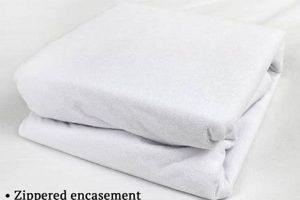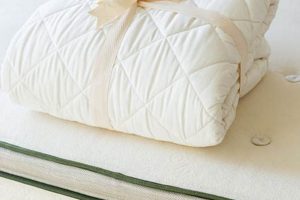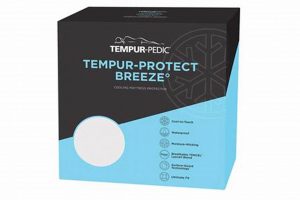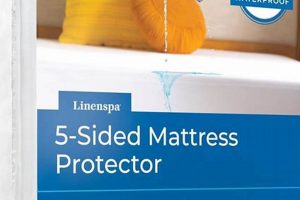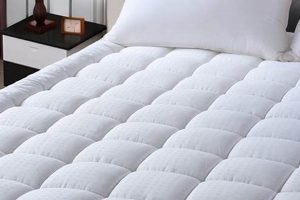The inquiry centers on the launderability of a fabric or material designed to shield a bed’s primary sleeping surface. This protective layer is typically placed over the mattress to defend against spills, stains, allergens, and dust mites. For instance, a zippered encasement made of waterproof polyurethane is a common example of this type of bedding accessory.
Regular cleaning of this item is crucial for maintaining hygiene and extending the lifespan of the mattress it covers. Removing accumulated dirt, bodily fluids, and allergens contributes to a healthier sleep environment and prevents degradation of the underlying mattress material. Historically, such protective measures were less common, leading to faster mattress wear and tear and increased allergen exposure for sleepers.
The following discussion will delve into the specific washing instructions for various types of these protective items, address potential washing challenges, and provide guidance on proper drying techniques to ensure continued effectiveness and prevent damage.
Washing Guidance for Mattress Protection
Effective maintenance of a mattress protector is essential for both hygiene and longevity. Adherence to the following guidelines will ensure proper cleaning and preservation of the protective barrier.
Tip 1: Review the Care Label: Prior to washing, examine the manufacturer’s instructions affixed to the item. These instructions specify recommended water temperatures, suitable cleaning agents, and drying methods to prevent damage.
Tip 2: Use Mild Detergent: Employ a gentle, hypoallergenic detergent. Harsh chemicals can degrade the protective layer or leave behind residues that may irritate sensitive skin.
Tip 3: Select Appropriate Water Temperature: Unless otherwise indicated, cold or lukewarm water is generally preferred. High heat can damage waterproof membranes and cause shrinkage.
Tip 4: Avoid Bleach: Refrain from using chlorine bleach. This chemical can weaken fibers and compromise the integrity of the protective barrier, particularly if it contains synthetic materials.
Tip 5: Consider a Second Rinse Cycle: Adding an extra rinse cycle ensures the complete removal of detergent residue, which can attract dust and allergens.
Tip 6: Tumble Dry on Low Heat: If machine drying is permitted, use the lowest heat setting. Excessive heat can melt or warp the protective layer. Air drying is often a safer alternative.
Tip 7: Ensure Complete Dryness: Before placing the protector back on the mattress, verify that it is completely dry. Dampness can promote mold and mildew growth.
Proper washing techniques preserve the effectiveness of the mattress protector, ensuring a cleaner and healthier sleeping environment. Careful attention to these recommendations will extend the lifespan of both the protector and the mattress itself.
The concluding section will summarize key considerations for optimizing mattress protector care.
1. Material Composition
The composition of a mattress protector directly dictates its washability and appropriate cleaning procedures. Different materials exhibit varying responses to water temperature, detergents, and drying methods. Understanding these material properties is crucial for maintaining the protector’s integrity and functionality through repeated washing cycles.
- Cotton
Cotton protectors are generally washable and durable. They can withstand warm water and moderate agitation. However, they are prone to shrinking, especially during the first wash. High heat drying can exacerbate shrinkage. Pre-shrinking processes during manufacturing can mitigate this effect to some extent, but users should still exercise caution.
- Polyester
Polyester protectors offer enhanced resistance to shrinking and wrinkling compared to cotton. They are generally machine washable and dryable, but low heat is recommended to prevent melting or distortion. Polyester is less absorbent than cotton, which can be advantageous for stain resistance, but may also require more thorough rinsing to remove detergent residue.
- Waterproof Laminates (e.g., Polyurethane)
Protectors with waterproof layers, such as those laminated with polyurethane, require specific care. High water temperatures and harsh detergents can degrade the waterproof membrane, compromising its effectiveness. Tumble drying on high heat is generally prohibited as it can melt or delaminate the protective layer. Air drying or tumble drying on the lowest heat setting is preferable.
- Blends (e.g., Cotton-Polyester)
Blended fabrics combine the properties of their constituent materials. A cotton-polyester blend offers a balance of comfort, durability, and wrinkle resistance. Washing instructions typically fall between those for pure cotton and pure polyester. Care should be taken to avoid settings that are too harsh for either component.
The interplay between material composition and washing methods directly influences the lifespan and protective capabilities of the mattress protector. Selecting appropriate cleaning procedures, guided by an understanding of the materials involved, optimizes both hygiene and product durability.
2. Care Label
The presence and proper interpretation of a care label are intrinsically linked to the launderability of a mattress protector. The care label serves as the definitive guide for cleaning and maintenance, directly impacting the efficacy and longevity of the protective bedding.
- Washing Instructions
The care label explicitly states whether the mattress protector is suitable for machine washing, hand washing, or dry cleaning only. It details the recommended water temperature (cold, warm, hot) and cycle settings (gentle, delicate, normal). For instance, a label might specify “Machine wash cold, gentle cycle.” Ignoring these instructions can lead to shrinkage, material damage, or compromised waterproofing.
- Detergent Recommendations
The label often advises on appropriate detergent types. It may caution against the use of bleach or fabric softeners, which can degrade certain materials. For example, “Do not bleach” indicates that chlorine-based bleach should be avoided to prevent discoloration or fiber weakening. Using a harsh detergent against recommendations can void warranties or reduce the protector’s effectiveness.
- Drying Instructions
The drying instructions are critical for preventing damage during the drying process. The label indicates whether the protector can be tumble dried (and at what temperature: low, medium, high), air dried, or line dried. Examples include “Tumble dry low” or “Line dry only.” High heat can melt waterproof layers or cause excessive shrinkage in some fabrics.
- Ironing and Other Care
Some labels may include instructions regarding ironing, stain removal, or other specialized care procedures. While less common, these instructions are essential for preserving the protector’s appearance and functionality. “Do not iron” may be indicated for protectors with heat-sensitive coatings.
Adhering to the guidelines provided on the care label ensures that the mattress protector is cleaned in a manner that preserves its protective qualities and extends its lifespan. Deviation from these instructions often results in irreversible damage, rendering the protector ineffective and necessitating replacement. Therefore, diligent review and adherence to the care label are paramount when considering the question of whether a mattress protector is washable and how it should be properly cleaned.
3. Water Temperature
Water temperature directly influences the outcome of laundering a mattress protector. The selection of appropriate water temperature dictates the effectiveness of stain removal, the preservation of fabric integrity, and the overall lifespan of the bedding item. Incorrect water temperature can cause irreversible damage, diminishing the protector’s function. For instance, washing a protector with a waterproof polyurethane layer in hot water can delaminate the waterproof membrane, rendering it ineffective.
The recommended water temperature is largely dependent on the fabric composition of the protector. Cotton protectors, while generally resilient, can shrink at high temperatures. Polyester protectors, while more resistant to shrinkage, may suffer damage to their fibers at elevated temperatures. Protectors with specialized coatings or laminates require even greater caution. The care label, as previously emphasized, provides the definitive guidance for water temperature. Deviations from these instructions can have significant consequences. A practical example involves a stain on a cotton protector; while warmer water might seem like a solution for stain removal, adherence to the care labels cold-water recommendation is paramount to prevent shrinkage.
Therefore, the “can I wash my mattress protector” question is intricately linked to the specific water temperature employed. Understanding the material composition, consulting the care label, and selecting the corresponding water temperature are critical for maintaining the protector’s hygienic and protective properties. Neglecting these considerations may result in premature wear, compromised waterproofing, and a reduction in the overall effectiveness of the mattress protection system.
4. Detergent Type
The selection of an appropriate detergent is a crucial determinant in the effective and safe laundering of a mattress protector. Incompatible detergents can compromise the protector’s fabric, waterproofing, or overall integrity, directly impacting its function and longevity.
- Harsh Chemicals and Waterproofing
Detergents containing harsh chemicals, such as bleach or strong enzymes, can degrade waterproof laminates like polyurethane. This degradation compromises the protector’s ability to prevent liquids from reaching the mattress, defeating its primary purpose. Non-chlorine bleach alternatives may be considered for stain removal, but only if explicitly approved on the care label. Abrasive chemicals can weaken the seams and the waterproof layer.
- Residue Buildup and Allergens
Some detergents leave behind residue, which can attract dust mites and allergens. This is particularly problematic for individuals with sensitivities or allergies. Opting for hypoallergenic detergents or those labeled “free and clear” minimizes the risk of residue buildup, promoting a cleaner and healthier sleep environment. Thorough rinsing is essential to remove any remaining detergent particles.
- Fabric Softeners and Breathability
Fabric softeners, while intended to improve fabric feel, can clog the pores of breathable mattress protectors. This clogging reduces airflow, potentially leading to increased heat retention and discomfort during sleep. The care label often advises against using fabric softeners to preserve the protector’s intended breathability and moisture-wicking properties.
- Enzymatic Cleaners and Delicate Fabrics
Enzymatic cleaners, designed to break down organic stains, may be too aggressive for delicate fabrics or coatings used in some mattress protectors. Over time, these enzymes can weaken the fibers, leading to premature wear and tear. A mild, pH-neutral detergent is generally a safer choice for protectors made of sensitive materials.
The interaction between detergent type and mattress protector material is a critical consideration for maintaining a clean and effective sleep surface. Careful attention to detergent composition and adherence to the care label’s recommendations will ensure the preservation of the protector’s functionality and extend its usable life. Therefore, the answer to can I wash my mattress protector is significantly influenced by the choice of detergent.
5. Drying Method
The method employed to dry a mattress protector directly impacts its structural integrity and long-term performance, fundamentally affecting the validity of the query “can I wash my mattress protector.” The washing process itself, irrespective of proper execution, can be rendered futile if the subsequent drying phase compromises the protector’s functional characteristics. Improper drying can induce shrinkage, delamination of waterproof membranes, and distortion of the fabric, thereby negating the benefits of cleaning.
For instance, a mattress protector composed of cotton and featuring a polyurethane waterproof layer may be safely machine washed on a gentle cycle. However, if this protector is then subjected to high heat in a tumble dryer, the polyurethane layer can melt or separate from the fabric. This renders the protector incapable of preventing liquid penetration, effectively nullifying its protective function. Conversely, air drying, although time-consuming, generally preserves the integrity of both the fabric and the waterproof layer. Similarly, some protectors may tolerate low-heat tumble drying, but only if the care label explicitly permits it. Understanding the consequences of each drying method is therefore critical. A common error involves using a dryer sheet with a protector; the chemicals in dryer sheets can coat the protector, decreasing its breathability and water resistance.
In summary, the successful washing of a mattress protector hinges not only on the washing process itself but also, and perhaps more critically, on the appropriate drying method. Adhering to manufacturer-specified drying instructions is essential to avoid damage and ensure the continued effectiveness of the protector. The inquiry about washability must therefore be broadened to encompass a thorough understanding of suitable drying techniques, failing which the intended benefits of cleaning will be undermined.
Frequently Asked Questions
This section addresses common inquiries regarding the cleaning and maintenance of mattress protectors, providing factual information to ensure optimal care.
Question 1: Can all mattress protectors be machine washed?
Not all mattress protectors are suitable for machine washing. The material composition and construction dictate appropriate cleaning methods. Consult the care label for specific instructions.
Question 2: What water temperature is recommended for washing a mattress protector?
The recommended water temperature varies depending on the fabric. Cold or lukewarm water is generally advised to prevent shrinkage or damage to waterproof layers. Refer to the care label for precise temperature guidelines.
Question 3: Is it safe to use bleach on a mattress protector?
The use of chlorine bleach is generally discouraged, as it can degrade the protector’s fabric or waterproof membrane. Consult the care label for approved cleaning agents. Non-chlorine bleach alternatives may be permissible in some cases.
Question 4: Can a mattress protector be tumble dried?
Tumble drying is permissible for some mattress protectors, but the heat setting must be carefully selected. High heat can damage waterproof layers or cause shrinkage. Air drying is often a safer alternative. Always consult the care label.
Question 5: How often should a mattress protector be washed?
The frequency of washing depends on usage and potential exposure to spills or allergens. A general guideline is to wash the protector every one to two months. More frequent washing may be necessary in cases of heavy soiling or allergen sensitivity.
Question 6: What type of detergent is best for washing a mattress protector?
A mild, hypoallergenic detergent is generally recommended. Harsh chemicals or enzymes can damage the protector’s fabric or leave behind residues that may irritate sensitive skin. Avoid detergents containing bleach or fabric softeners unless explicitly approved on the care label.
Proper cleaning of a mattress protector prolongs its lifespan and maintains a hygienic sleep environment. Always adhere to the manufacturer’s instructions for optimal results.
The following section summarizes key considerations for effective mattress protector maintenance.
Concluding Considerations
The inquiry “can I wash my mattress protector” is not a simple yes or no proposition. This exploration has demonstrated that successful laundering necessitates careful consideration of material composition, adherence to care label instructions, appropriate water temperature selection, the use of compatible detergents, and the implementation of suitable drying methods. Neglecting any of these factors can compromise the protector’s integrity and effectiveness, ultimately undermining its intended purpose.
Therefore, thorough understanding and diligent application of the guidelines outlined herein are essential for maintaining a clean and hygienic sleep environment. Prioritizing informed decision-making will ensure both the longevity of the mattress protector and the continued protection of the underlying mattress, contributing to improved sleep quality and overall well-being.


